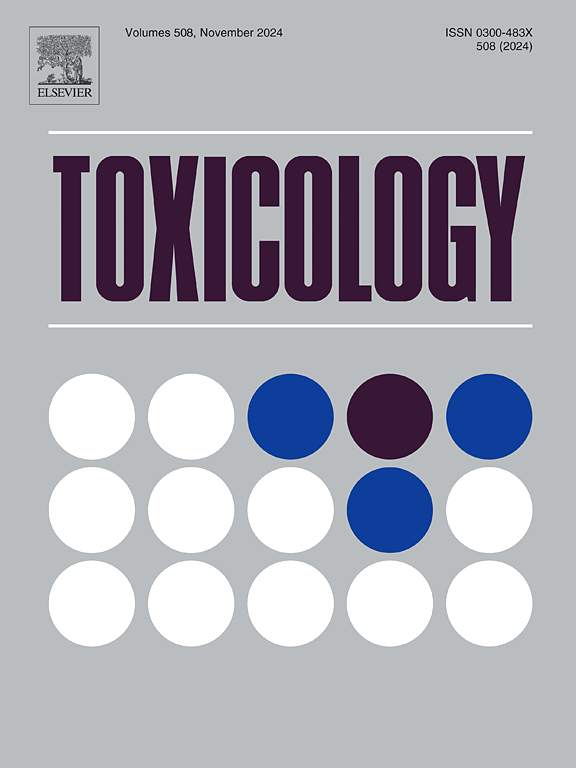基于网络毒理学和分子对接的方法揭示了除草剂2,4- d及其代谢物2,4- dcp之间共享的肝毒性机制和靶点。
IF 4.8
3区 医学
Q1 PHARMACOLOGY & PHARMACY
引用次数: 0
摘要
除草剂2,4-二氯苯氧乙酸(2,4- d)及其主要环境代谢物2,4-二氯苯酚(2,4- dcp)是与肝毒性相关的污染物,其分子机制尚不清楚。本研究通过蛋白-蛋白相互作用(PPI)网络分析和分子对接,探讨了2,4- d和2,4- dcp诱导肝毒性的分子通路和靶点。使用PharmMapper和SwissTargetPrediction鉴定靶基因,并与GeneCards和OMIM数据库中的肝毒性相关基因进行交叉比对。通过STRING构建的PPI网络在Cytoscape中显示出12个关键枢纽节点,包括HSP90AA1、RXRA、EGFR、SRC、CREBBP、PIK3R1、ESR1、AKT1、RAF1、IGF1R、MDM2和MAPK14。基因本体(GO)分析表明凋亡、氧化应激、线粒体功能障碍和脂质代谢损伤等过程,而Reactome通路分析强调PI3K/AKT和核受体信号的中断。分子对接证实2,4- d和2,4- dcp与SRC、AKT、RXRA、MDM2和HSP90AA1等关键蛋白有显著的相互作用。这些结果表明2,4- d和2,4- dcp具有相似的毒性机制,首次为其肝毒性途径提供了新的见解。本文章由计算机程序翻译,如有差异,请以英文原文为准。

A network toxicology and molecular docking-based approach revealed shared hepatotoxic mechanisms and targets between the herbicide 2,4-D and its metabolite 2,4-DCP
The herbicide 2,4-dichlorophenoxyacetic acid (2,4-D) and its major environmental metabolite 2,4-dichlorophenol (2,4-DCP) are pollutants associated with hepatotoxicity, whose molecular mechanisms remain poorly understood. This study investigated the molecular pathways and targets involved in 2,4-D and 2,4-DCP-induced hepatotoxicity using protein-protein interaction (PPI) network analyses and molecular docking. Target genes were identified using PharmMapper and SwissTargetPrediction, and cross-referenced with hepatotoxicity-related genes from GeneCards and OMIM databases. The PPI network, constructed via STRING and visualized in Cytoscape, revealed 12 critical hub nodes, including HSP90AA1, RXRA, EGFR, SRC, CREBBP, PIK3R1, ESR1, AKT1, RAF1, IGF1R, MDM2, and MAPK14. Gene Ontology (GO) analysis indicated processes such as apoptosis, oxidative stress, mitochondrial dysfunction, and lipid metabolism impairment, while Reactome pathway analysis highlighted disruptions in PI3K/AKT and nuclear receptors signaling. Molecular docking confirmed significant interactions of 2,4-D and 2,4-DCP with key proteins, including SRC, AKT, RXRA, MDM2, and HSP90AA1. These results suggest that 2,4-D and 2,4-DCP share similar toxic mechanisms, providing new insights into their hepatotoxicity pathways for the first time.
求助全文
通过发布文献求助,成功后即可免费获取论文全文。
去求助
来源期刊

Toxicology
医学-毒理学
CiteScore
7.80
自引率
4.40%
发文量
222
审稿时长
23 days
期刊介绍:
Toxicology is an international, peer-reviewed journal that publishes only the highest quality original scientific research and critical reviews describing hypothesis-based investigations into mechanisms of toxicity associated with exposures to xenobiotic chemicals, particularly as it relates to human health. In this respect "mechanisms" is defined on both the macro (e.g. physiological, biological, kinetic, species, sex, etc.) and molecular (genomic, transcriptomic, metabolic, etc.) scale. Emphasis is placed on findings that identify novel hazards and that can be extrapolated to exposures and mechanisms that are relevant to estimating human risk. Toxicology also publishes brief communications, personal commentaries and opinion articles, as well as concise expert reviews on contemporary topics. All research and review articles published in Toxicology are subject to rigorous peer review. Authors are asked to contact the Editor-in-Chief prior to submitting review articles or commentaries for consideration for publication in Toxicology.
 求助内容:
求助内容: 应助结果提醒方式:
应助结果提醒方式:


